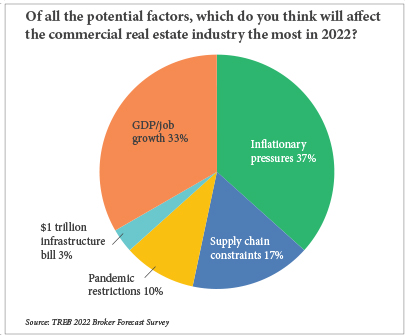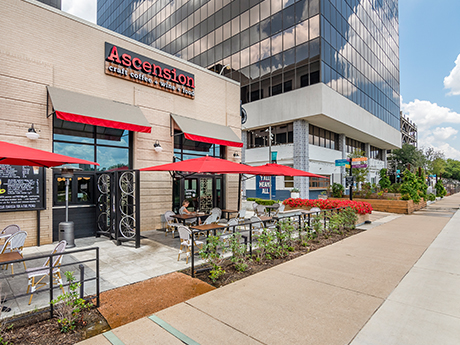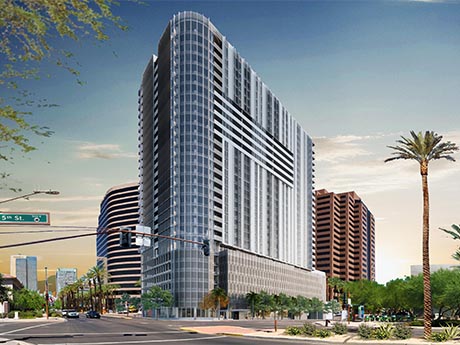The “retail apocalypse” predicated on the pandemic never really materialized. Instead, we’ve seen retail do what it always does: evolve. Much as the rest of the country, metro Detroit’s retail real estate market has evolved and come back in a big way. Tenants on the move As vaccines were adopted and the economy allowed to reopen, the economic rubber band snapped back quickly and stronger than many of us could have predicted. Retailers were dusting off pre-pandemic expansion plans and back to signing leases in 2021. We saw new openings and new market searches from BJ’s Wholesale Club, Burlington, Carvana, Chick-fil-A, Chipotle, Starbucks, Crunch Fitness, Edge Fitness, Gabe’s, iFly, Jollibee, Meijer, Portillo’s, Ross, Shake Shack, Smoothie King, T.J. Maxx, Total Wine & More and Tropical Smoothie Café. 2021 also presented a big void in the Michigan furniture market following the bankruptcy of Art Van (which controlled 30 to 35 percent of the market). Numerous players including Gardner White Furniture, Ashley Furniture and Value City Furniture all quickly snapped up this real estate, immediately increasing their market share. Other categories that continue to seek space include car washes (which has to be one of the most active categories out there …
Market Reports
By Clara Wineberg, principal and executive director, SCB Boston As we have all been forced to reexamine how we interact with and live in our homes during two years of a global pandemic, lessons learned for architects, developers and interior designers have been bountiful. In early 2020, those of us in the multifamily industry were wary about how we would make it all work; now, however, we realize the challenges we have faced in the last 24 months have provided immense opportunities to improve design of modern housing communities. In 2022 and beyond, multifamily design will continue to evolve to meet the changing definition of “home,” and how it connects us to our loved ones, communities and even ourselves. Everything From Home While home used to be just a place to hang one’s hat at the end of the day, in 2020, home took on a whole new meaning. It became not only the place we rest, but also our workplace, our children’s classroom, our fitness center and our entertainment venue. Our whole lives were — and to some extent still are — encapsulated within our homes. We expect this trend to continue moving into the future post-pandemic world. The …
By Taylor Williams In late October, Raphael Bostic, president of the Federal Reserve Bank of Atlanta, gave a virtual speech in which he carried a glass jar with the word “transitory” labeled on it. Inside the jar were wadded-up dollar bills, deposited by Bostic’s staff members each time they used the word “transitory” to describe the surge in prices of consumer goods and services. The exercise was meant to dispel the notion that the current inflationary environment would be fleeting or short-lived. Based on the results of Texas Real Estate Business’ annual reader forecast survey, commercial brokers and developers/managers in the Lone Star State aren’t likely to be contributing to that fund any time soon. When asked to identify the macroeconomic force that was most likely to impact the commercial real estate industry in 2022, both of these groups selected inflationary pressures over supply chain constraints, pandemic restrictions, the $1 trillion infrastructure bill and employment/gross domestic product (GDP) growth. It’s worth noting that the survey officially closed on Monday, Dec. 13, about a week before the nation began to see a major surge in COVID-19 cases, most of which were classified as the Omicron variant. In the subsequent three-week period, …
The Raleigh-Durham region is experiencing increasing optimism despite the lingering impacts of COVID-19. While some reentry plans have been delayed and companies are still grappling with the way in which they will utilize office space moving forward, tenant demand is expected to rebound sharply in the first half of 2022. “We’ve seen an encouraging uptick in tenant activity since the second quarter of 2021, and we expect that trend to accelerate,” says Kathy Gigac, principal of Avison Young and a member of the firm’s Occupier Solutions Team. “Tenants seem ready to get back to some sense of normalcy.” Local economic fundamentals are sound, as reopening efforts and positive job growth have allowed Raleigh-Durham’s unemployment rate to recover from a pandemic high of 12 percent to 3.2 percent as of Sept. 2021. The region continues to witness major economic development wins with companies such as Google and Apple announcing plans to create thousands of new jobs. In its largest presence on the East Coast, Apple will invest $1 billion over a 10-year period to create a 3,000-job campus to eventually span 1 million square feet. In the most recent announcement from an office-using tenant, Fidelity Investments will add 1,500 jobs in …
A lot has changed in the world since the beginning days of the COVID-19 pandemic in early 2020. Fast forward to November 2021 and the world is a very different place. Over 46 million people have been infected in the United States alone with over 750,000 deaths officially attributed to the virus. Most businesses have been forced to shut down in-person work for some period of time and many have instituted remote work programs until the beginning of 2022. The real question on everyone’s mind is when will we return to normal and more specifically, what will the new normal look like? Although we will most certainly have to deal with the aftereffects of COVID-19 and any variants that surface, there is light at the end of the tunnel. To date, approximately 427 million doses of the vaccine have been administered with over 192 million people fully vaccinated. Recently, Pfizer announced that it has developed an easy-to-administer COVID-19 pill, which when used in combination with a widely used HIV drug, can cut the risk of hospitalizations or death by 89 percent in high-risk adults who have been exposed to the virus. Given the combination of vaccinations, natural immunity for those …
By Taylor Williams Northern New Jersey is teeming with new multifamily projects, many of them transit-oriented, that mesh suburban locations with urban lifestyles, making the region a desirable alternative to living in New York City. But more housing product is unquestionably needed. According to the U.S. Census Bureau, the Garden State’s population grew by 5.7 percent from approximately 8.8 million to 9.3 million in 2020. New Jersey is the 11th-most populous state and the fifth-smallest state by area, and thus has the highest level of population density in the country. The combination of a growing population and a very limited supply of land means that infill development sites that provide direct access to major cities, most notably New York City and Philadelphia, are highly coveted by developers of all property types. But developers that can deliver the right kind of housing on those sites play central roles in helping municipal leaders bring new jobs, retailers and restaurants to their communities. CENTURION Union Center, a mixed-use project which includes nearly 300 new homes and approximately 27,000 square feet of retail space, is just one such project that ties together a basic need for housing with a larger revitalization of the community. …
By Taylor Williams The factors that have long enticed Texas retailers and restaurants to locate in mixed-use environments are back in full force, such that these users are once again willing to pay a premium for spaces built-in density and walkability. In some ways, this trend never really disappeared in Texas, one of the first states to reopen during the early months of COVID-19. Through measures passed in 2020 like sanctioning to-go alcohol sales and allowing businesses to stay open, albeit at reduced capacities, Texas has worked to minimize retail and restaurant closures and prevent large volumes of these spaces from being returned to markets. Neither has the state’s job and population growth slowed during the 22-month global health crisis, allowing developers across all asset classes to push forward. In addition, the newfound desire from consumers and businesses to work, shop and dine outdoors as much as possible has kept trains rolling on mixed-use projects, which inherently connect different uses through external features like trails, open streets, pocket parks and plazas. From a design standpoint, those connective features remain critically important, says Barry Hand, principal in the Dallas office of global architecture firm Gensler. “Pocket or linear parks are viewed …
Mixed-Use Projects, Mall Redevelopments Headline Triangle’s Retail Development Activity
by John Nelson
The end of 2021 in Raleigh-Durham was marked by robust retail leasing and an increased level of investment sales in our suburbs and infill trade areas. Downtown Raleigh, Durham and Chapel Hill have lagged in activity, although each urban environment started to see a resurgence by mid-year, and notably Downtown Raleigh ended 2021 with record retail leasing activity. Population growth and major economic development announcements are driving these positive trends. Apple, Google, FujiFilm, several life sciences companies and most recently Toyota (just east of the Raleigh-Durham region) have highlighted economic expansion. Strong demand and a healthy retail construction pipeline have held retail vacancy to 7.1 percent despite headwinds from the COVID-19 pandemic. The healthy retail development pipeline includes several new mixed-use projects. Cary will see one of the largest active mixed-use projects in the Southeast deliver this year when Fenton opens in the spring. Hines and Columbia Development are currently finalizing the first phases of the project. Spread over 92 acres, Fenton will initially include retailers such as Pottery Barn, Williams-Sonoma and Superica, as well as apartments and office space. Over in Research Triangle Park (RTP), the Research Triangle Foundation and White Point Partners have announced Horseshoe at Hub RTP. …
By Steve Nosrat, Principal, Avison Young As we prepare to close out 2021, Las Vegas continues to thrive, maintaining its place as one of the fastest-growing multifamily markets in the nation. Clark County’s population grew by 2 percent — nearly 40,000 — ranking it among the top 10 metros with at least 750,000 residents. This has further increased the already high demand for multifamily properties. Annual job growth in Las Vegas has outperformed the national average for five straight months, with leisure and hospitality jobs driving most of the recovery. Housing demand and rents are hitting all-time highs all over the Valley. Home values have risen 23 percent annually, and apartment rents are up 22 percent. Vacancy rates are down to just 3.8 percent, compared to the national index of 4.5 percent. This has spurred investors on, causing them to feel more secure with Las Vegas’ long-term outlook. Apartment sales passed $1 billion in the second quarter of 2021, which has only happened twice before in Las Vegas history. The 12-month sales volume has passed $3.1 billion and is trending positively for 2022, according to CoStar. The apartment market gained significant momentum during the third quarter. Cap rates have compressed, and …
By Matt Pesch, Vice Chairman, CBRE The multifamily market in Phoenix experienced a record-setting year in 2021. Market vacancy dropped below 3 percent for the first time, the region led all U.S. metros in year-over-year rent growth for every quarter and total multifamily investment sales volume topped $12 billion. This was nearly double the volume from 2019 and a 125 percent jump from 2020. These metrics are driven by Phoenix’s primary economic drivers of nation-leading population and job growth. As of October, Phoenix was one of only four U.S. metros to recover 100 percent of the jobs the region lost during the pandemic. This was driven by the stable recovery of long-established industries and growing sectors that are diversifying the region’s employment base. Case in point: Phoenix is home to one of the fastest-growing biotech sectors in the U.S. with the life sciences workforce expanding by 8.5 percent from 2019 to 2020, according to CBRE’s latest research. Likewise, large corporate office users continue to relocate or expand in Phoenix at an unprecedented rate, further driving the region’s robust employment recovery. The area’s strong employment recovery and population growth are the fuel driving Phoenix’s multifamily sector. The gains in the apartment …









